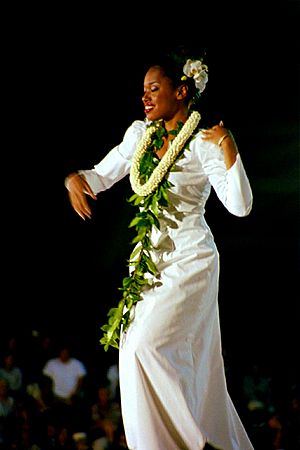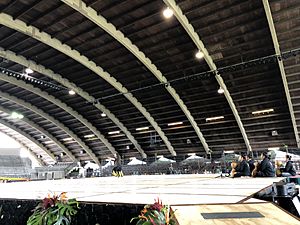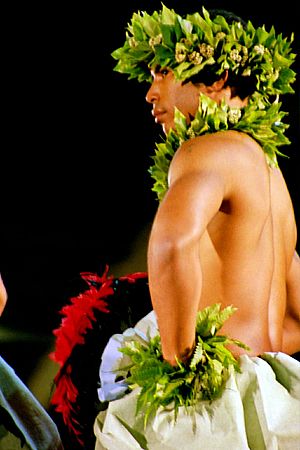Merrie Monarch Festival facts for kids
The Merrie Monarch Festival is a big cultural event in Hilo, Hawaii. It lasts for a week, starting the week after Easter every year. This festival celebrates King David Kalākaua. People called him the "Merrie Monarch" because he loved the arts. He helped bring back many Hawaiian traditions, especially the hula dance.
Many hālau hula (hula schools) come to the festival. They come from Hawaii, the U.S. mainland, and even other countries. They perform and compete in hula. The Merrie Monarch Festival is famous worldwide. It is known as the most important hula competition.
Merrie Monarch week always starts on Easter Sunday. The main hula competitions happen on Thursday, Friday, and Saturday. These events are shown on TV and online by KHII-TV. The 2020 festival was canceled because of the coronavirus pandemic.
Contents
Festival History
The Merrie Monarch Festival honors King David Kalākaua. He was the last king of the Kingdom of Hawaii. He ruled from 1874 until 1891. King Kalākaua loved art, music, and dance. He helped bring back many Hawaiian traditions. These included Hawaiian stories, medicine, and chants. He also strongly supported the hula dance. Many of these traditions had been stopped for years.
The festival is named "Merrie Monarch" after King Kalākaua's nickname. He was known for being happy and kind to his people. The festival's design is like Kalākaua's Silver Jubilee. This was a two-week Hawaiian culture celebration. It happened on his 50th birthday in 1886.
The Merrie Monarch Festival began in 1963. Helene Hale started it to bring more tourists to the Island of Hawaii. The island's economy was struggling. She hoped a festival would help. Helene Hale, along with George Naʻope and Gene Wilhelm, held the first festival in 1964. It had fun events like a King Kalākaua look-alike contest.
George Naʻope was a famous Kumu Hula. A Kumu Hula is a teacher of Hawaiian dance. He learned hula from his great-grandmother at age three. He later started his own hula school. He taught hula in many countries around the world. His main goal was to keep Hawaiian culture alive. He saw the festival as a great way to do this.
By 1968, the festival was not as popular. Dottie Thompson became the new Executive Director. She changed it into a community event. Thompson wanted the festival to focus more on Hawaiian culture. She did this by making hula the main part of the festival. In 1971, Thompson and Naʻope started a hula competition. Nine wahine (female) hālau joined the first year. In 1976, kāne (male) hālau were also allowed to compete.
Today, the Merrie Monarch Festival is a week-long event. It ends with three days of important hula competitions. It is now a non-profit group. Money from the festival helps fund scholarships and workshops. It also helps keep the festival going each year.
The Royal Court
A Royal Court is chosen for the festival. They represent the King, Queen, and their family. Uʻilani Peralto and Luana Kawelu organize the Royal Court. They look for a male and female to play King Kalākaua and Queen Kapiʻolani.
The selection committee looks for people who are mature and humble. They must also be proud of Hawaiian culture. Like the hālau, court members are carefully chosen. The court has 22 members. These are often friends and family of the chosen king and queen. Other members include a counselor and kahu (caretaker). There are also ladies-in-waiting, kahili bearers, chanters, and pu kane (conch shell blowers). Each person learns about their role. They also learn about King Kalākaua's mission. The Royal Court shows Hawaiian history and spirit.
Festival Activities
The Merrie Monarch Festival happens every spring. It runs from Easter Sunday morning to Saturday evening.
Non-Competition Events
The first four days of the festival have free events. These are not competitions. Local and international hālau perform in Hilo. There is also an arts and crafts fair. The Wednesday Ho'ike Night is very popular. It often features hālau from other Pacific islands and Japan. Dancers from Alaska and New Zealand also perform. A parade, the Merrie Monarch Parade, happens on Saturday morning.
Hula Competition

The main events are the competitions. They are held at the Edith Kanakaʻole Multipurpose Stadium. Dancers perform alone and in groups. Each performance lasts seven minutes.
Miss Aloha Hula
Thursday night is the first competition. Individual female dancers compete for Miss Aloha Hula. Dancers perform both modern (hula ʻauana) and traditional (hula kahiko) hula. They also perform chants (oli).
Miss Aloha Hula is the top award for a solo female dancer. It was first called Miss Hula. Aloha Dalire won the first Miss Aloha Hula in 1971.
Group Hula Kahiko
There are two group divisions: male (kāne) and female (wahine). Friday night features hālau performing ancient style hula.
Group Hula ʻAuana

Saturday night features hālau performing modern style hula. The awards are also announced on Saturday night.
Judging Criteria

Judges score hālau and individual dancers. They look at the entrance (kaʻi) to the stage. During the chant (oli) and dance (hula), judges check many things. These include how well the song is shown. They also look at expression, posture, and precision. Hand gestures, footwork, and body movement are important. Grooming and costume authenticity are also judged. Finally, they score the exit (hoʻi) from the stage.
Cultural Impact
Many people believe the Merrie Monarch Festival helped Hawaiian culture grow again. The festival has four main goals for Hawaiian culture. First, to keep Hawaiian traditions alive. Second, to share Hawaiian arts and crafts. Third, to reach people who might not learn about the culture otherwise. Fourth, to make the future better for Hawaii's children.
The festival says it teaches thousands of people about Hawaiian history and culture. The Merrie Monarch Festival is famous worldwide. It is known for its important history and culture.
Nā Hiwahiwa O Hawai'i Festival, Japan
For some hālau, the festival continues after the competition. Winners are invited to the Nā Hiwahiwa Festival in Tokyo, Japan. This festival celebrates Merrie Monarch winners. It also includes Nā Hōku Hanohano music award winners. Japan is a big supporter of hula and Hawaiian culture. Japanese hula schools do not compete in Merrie Monarch. However, many travel to Hilo each year. They support the hālau and enjoy the festival.
Television Coverage
The festival was first shown on local TV in 1981 by KITV. At first, it was taped highlights. Later, it became a live broadcast. KITV showed the festival for 29 years. In 2009, Luana Kawelu, the festival president, signed a deal. The festival has been broadcast by KFVE (now KHII-TV) since 2010.




